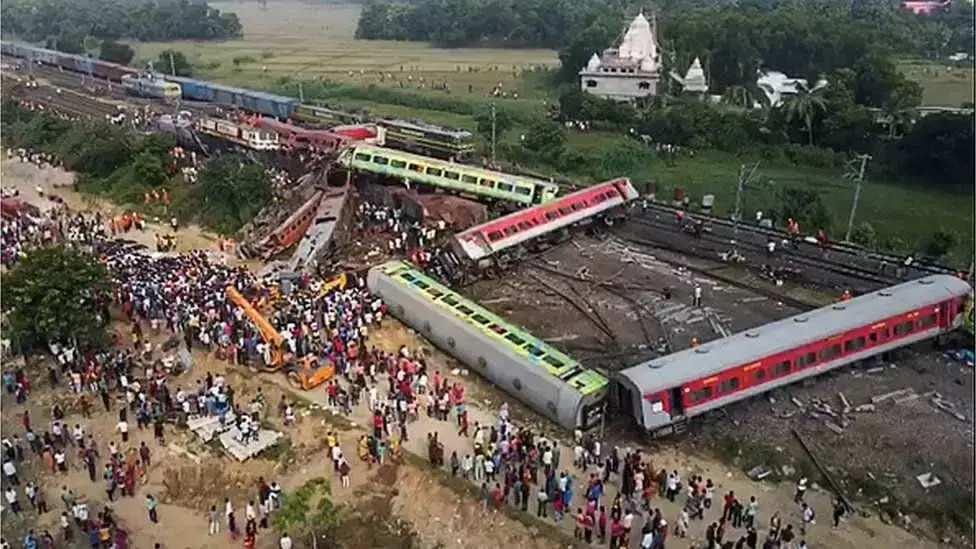There Is More To A Railway Tragedy Than Meets The Eye
Nearly 24,000 deaths are caused by railway accidents in a year in India;

The recent disastrous Odisha train accident has re-emphasised the need for ensuring better train safety. Taking an average figure for the last decade, nearly 24,000 deaths are caused by railway accidents in a year. This may be compared to less than 700 deaths in the entire European Union related to train accidents in 2021.
In India the deaths caused by train accidents in 2021 were lower than the average for the last decade, and one reason may be that the sharp dip in rail traffic during COVID took time to recover in 2021. Anyway, the number of railway accidents in India in 2021 was 17,993 and the number of deaths caused by them was 16,431, or about 1 death per accident. The number of injuries has been recorded at only 1852, or only one injury per 10 accidents.
It is clear that the number of injuries has been seriously underestimated. How can 10 railway accidents together result in only one injury? In the case of the European Union the number of ‘serious’ injuries has been almost at par with or equal to the number of fatalities, while if less serious injuries too are counted this may be much higher.
In the case of the United States, the number of injuries is much higher than the number of fatalities. This is likely to be true in India as well.
Here we may mention that in the case of road accidents also the number of injuries has been highly underestimated in official data in India.
Hence, it is likely that, if the number of injuries is almost double that of fatalities, then the number of injuries in railway accidents may have been under-estimated by about 31,000 or so during 2021.
We should remember that most railway accident injuries in India are likely to be of a serious nature, involving a lot of expenditure and economic costs as well for victims.
The data for railway crossing accidents is provided separately in official data. This shows that in 2021 there were 1505 railway accidents in which 1807 people died and 148 were injured.
Here again the same pattern is revealed, one death per accident but only one injury per 10 accidents. Here again it is clear that the number of injuries is very substantially understated.
While the data for rail accidents and railway crossing accidents is given in official data, no separate data are provided for accidents which take place at railway platforms. However, from time to time there are reports of people dying in stampedes at railway stations or dying from electric shocks or other accidents.
Recently there was a report of eight workers being electrocuted to death near a railway gate in Dhanbad district ( Jharkhand). Injuries are much more common.
In big railway stations, big crowds on platforms often result in injuries, particularly on staircases. One high risk situation often occurs when the platform for a departing train is changed just before the departure time. This leads to a huge surge of people, in which the probability of stampedes increases significantly.
In smaller stations people often get no guidance regarding the point where they can board their train coach, while the train stops for a short time. This can result in injury while rushing to board the train with luggage, and also disembarking at such small stations with luggage at night hours.
Suicides involving railways are listed separately in the European Union data, as railway suicide deaths there are over three times the number who die in railway accidents. In India there is no comparable data for railway suicides, although it is well known that several suicides take place on railway tracks. In Mumbai there are about one hundred suicides at railway tracks reported in a year.
Nearly two-thirds of the railway accident deaths result from falls and people getting run over, and one can imagine that most of these people come from very poor backgrounds. In Mumbai Metropolitan Area train tracks there were 2,507 deaths and 2,155 injuries in 2,022 (official deaths) with about 1,100 deaths caused at the time of crossing railway tracks and about 700 caused due to falls from running trains.
These victims are mostly from economically weaker sections. While the risks in suburban trains here are much higher, the authorities have been more concerned regarding insurance cover for metro passengers.
In a great human tragedy, in 2020 when due to COVID very few passenger trains were running, nearly 8,700 poor people died while walking along rail tracks. They were mostly migrant workers and their family members, including children, walking back to their homes in distant villages.
Their reflexes had probably been slowed by hunger, thirst and tiredness from walking very long distances. However, in this official data too there may be under-estimates as the number of injured was mentioned at only one tenth of fatalities.
Incidentally, at the time of writing this article the number of injuries caused in the Odisha train accident is about 1000. This is over three times the number of deaths reported so far for this serious accident.
Here it should be emphasised that the nature of many railway accident injuries is generally quite serious. The government must arrange for proper free treatment and rehabilitation of all injured victims, apart from providing financial compensation.
Beyond this there is a need for higher priority being accorded to railway safety. The focus should be much more on safety, and basic comforts of ordinary passengers, than on luxury and bullet trains.
Bharat Dogra is Honorary Convener, Campaign to Save Earth Now. Views expressed are the writer’s own.

